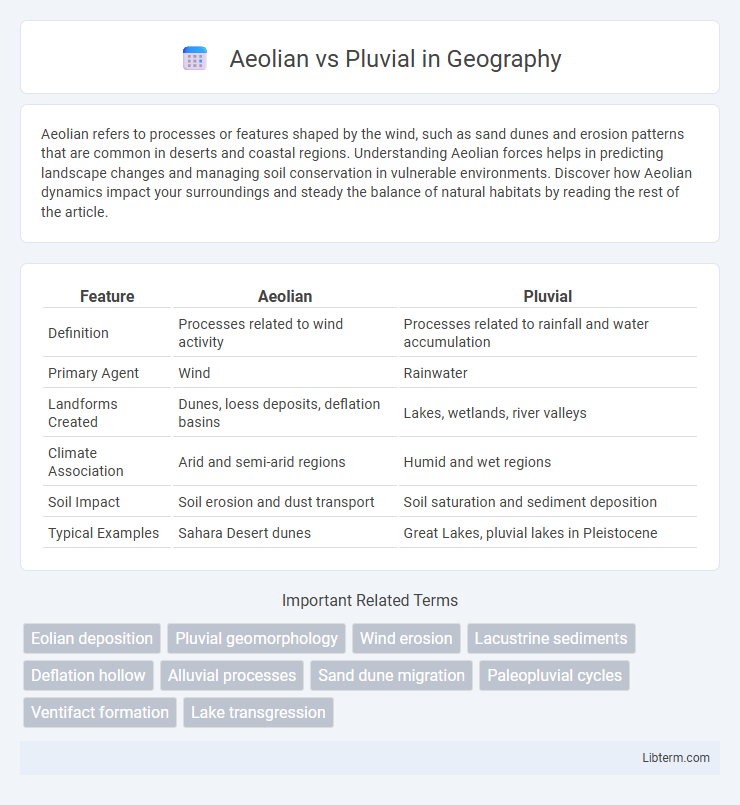Aeolian refers to processes or features shaped by the wind, such as sand dunes and erosion patterns that are common in deserts and coastal regions. Understanding Aeolian forces helps in predicting landscape changes and managing soil conservation in vulnerable environments. Discover how Aeolian dynamics impact your surroundings and steady the balance of natural habitats by reading the rest of the article.
Table of Comparison
| Feature | Aeolian | Pluvial |
|---|---|---|
| Definition | Processes related to wind activity | Processes related to rainfall and water accumulation |
| Primary Agent | Wind | Rainwater |
| Landforms Created | Dunes, loess deposits, deflation basins | Lakes, wetlands, river valleys |
| Climate Association | Arid and semi-arid regions | Humid and wet regions |
| Soil Impact | Soil erosion and dust transport | Soil saturation and sediment deposition |
| Typical Examples | Sahara Desert dunes | Great Lakes, pluvial lakes in Pleistocene |
Introduction to Aeolian and Pluvial Processes
Aeolian processes refer to the transportation, erosion, and deposition of sediments by wind, commonly shaping desert landscapes and creating features such as dunes and loess deposits. Pluvial processes involve the actions of water from precipitation, including runoff, infiltration, and sediment movement during wet periods, often leading to river development and soil formation. Both processes significantly influence Earth's surface dynamics, with aeolian activity dominating arid regions and pluvial action shaping environments with higher moisture availability.
Key Differences Between Aeolian and Pluvial Mechanisms
Aeolian mechanisms involve the transportation and deposition of sediments by wind, primarily affecting arid and semi-arid regions where loose, dry particles are easily lifted and moved. Pluvial processes, on the other hand, are driven by rainfall and runoff, shaping landscapes through water erosion, sediment transport, and deposition in wetter climates. Key differences include the medium of sediment movement (air versus water), the environmental conditions favoring each process, and the distinct landforms they create, such as dunes from aeolian activity and alluvial fans from pluvial processes.
Aeolian Processes: Definition and Examples
Aeolian processes involve the erosion, transport, and deposition of sediments by wind, primarily shaping arid and semi-arid landscapes. Key examples include the formation of sand dunes in deserts like the Sahara and the deflation hollows created in regions with sparse vegetation. These wind-driven actions significantly influence soil distribution, landscape morphology, and sedimentary environments.
Pluvial Processes: Definition and Examples
Pluvial processes refer to geological and geomorphological changes driven by rainfall and surface water runoff, often resulting in soil erosion, sediment transport, and the formation of river valleys and alluvial fans. Examples of pluvial processes include the development of floodplains through repeated flooding events, the creation of deltas where rivers deposit sediments as they enter a standing body of water, and the shaping of landscapes via sheet wash and rill erosion. These processes contrast with aeolian actions, which are primarily driven by wind rather than water.
Geomorphological Impacts of Aeolian Activity
Aeolian activity significantly shapes landscapes through processes such as deflation and abrasion, leading to the formation of features like sand dunes, loess deposits, and ventifacts. Wind-driven sediment transport redistributes fine particles, modifying surface textures and influencing soil development in arid and semi-arid regions. In contrast, pluvial processes primarily involve water erosion and deposition, affecting geomorphology through river incision, sedimentation, and valley formation.
Landforms Created by Pluvial Action
Pluvial landforms primarily develop through the action of rainwater and surface runoff during periods of increased precipitation or wet climates, leading to features such as alluvial fans, braided river valleys, and playa lakes. Unlike aeolian processes driven by wind, pluvial action shapes landscapes via sediment deposition and erosion caused by flowing water, creating intricate drainage networks and sedimentary basins. These landforms often indicate past climatic conditions and are crucial for understanding paleoenvironmental changes in arid and semi-arid regions.
Environmental Factors Influencing Aeolian and Pluvial Processes
Aeolian processes are primarily influenced by wind strength, surface dryness, and sediment availability, which facilitate the transportation and deposition of particles in arid and semi-arid environments. Pluvial processes depend on rainfall intensity, soil permeability, and vegetation cover that govern water runoff, infiltration, and erosion rates in wetter climates. Both processes are shaped by climatic variations, topography, and land use, affecting landscape evolution and sediment dynamics.
Aeolian vs Pluvial: Effects on Soil and Sediment Transport
Aeolian processes primarily involve the movement and deposition of soil and sediment through wind action, resulting in features such as dunes, loess deposits, and deflation hollows. Pluvial effects, driven by water from rainfall and runoff, influence soil erosion, sediment transport, and landscape shaping through mechanisms like sheet wash, rills, and fluvial deposition. The interaction between aeolian and pluvial dynamics determines sediment distribution patterns and soil fertility in arid and semi-arid environments.
Human Impact on Aeolian and Pluvial Systems
Human activities intensify aeolian processes through deforestation, overgrazing, and land clearance, increasing soil erosion and desertification risks. Urbanization and agriculture alter pluvial systems by changing natural water runoff patterns, causing flooding and water quality degradation. Infrastructure development disrupts both aeolian and pluvial dynamics, amplifying sediment transport and hydrological imbalances.
Conclusion: Comparing Aeolian and Pluvial Processes
Aeolian processes primarily involve wind-driven sediment transport and deposition, shaping landscapes such as deserts and dune fields, while pluvial processes are related to water accumulation and runoff, influencing fluvial erosion and floodplain development. Aeolian dynamics dominate in arid environments with sparse vegetation, whereas pluvial influences prevail in regions with higher precipitation and active hydrological cycles. Understanding the interplay between aeolian and pluvial forces is essential for interpreting geomorphological features and predicting landscape evolution in varying climatic conditions.
Aeolian Infographic

 libterm.com
libterm.com